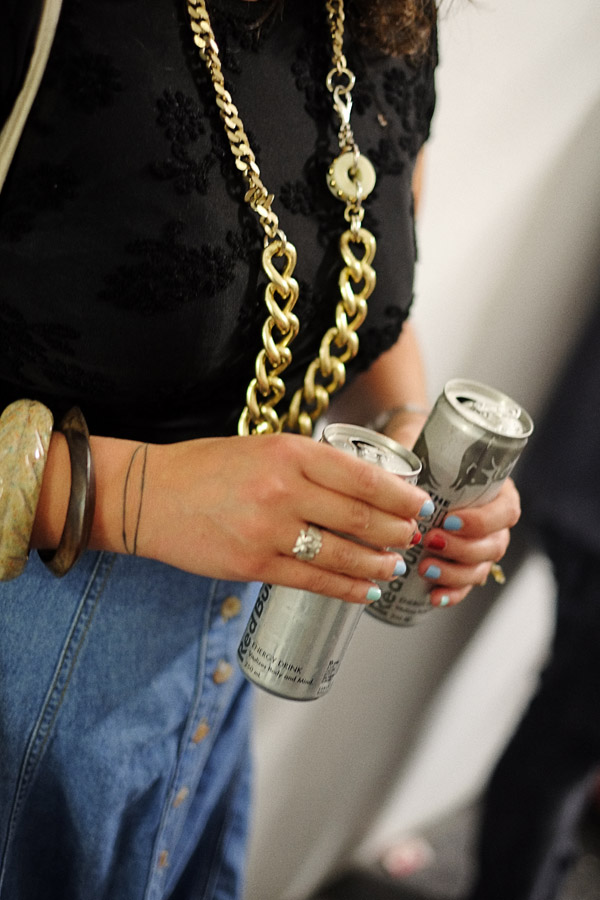The first thing everyone notices about the X-Pro1 is its great retro styling. It's a Rangefinder style camera where you can use the offset eyepiece as either an optical or video viewfinder or you can use the LCD screen on the back as you would with a point and shoot. The camera has all the old school knobs and dials, shutter speed on the top of the body, F-Stops on the lens barrel along with a silky smooth and responsive manual focus ring. The body and lenses are a minimalist shiny black on metal and these distinctive good looks are a real advantage when it comes to catching someone's attention when I ask them if I can take their portrait.
While the X-Pro1 has the options of Aperture/Shutter priority or Programme, set with the red A on the Speed and Aperture Dial I like having the traditional layout of apertures on the lens not on a command dial and the same goes for the shutter speed knob on the body. This is a camera that you work with like a traditional film camera and for me that has had positive results in having me think more photographically about what I am doing when I make my shots.
The process of thinking more photographically about your shots flows through to Fujifilm's focusing system. Most importantly and impressively the focusing of the X-Pro1 is bang-on accurate. And as of the 2.0 firmware update for the body and the lenses, auto-focus (and manual) is quick and responsive and while admittedly not being blindingly fast it is highly unlikely you will miss a shot - and the shot will be in focus. That's the sort of thing that builds a lot of photographer confidence when using a camera and the Fuji has it in spades. Fujifilm have also done something with the focusing system that at first seems quite unusual. Unlike most cameras you do not have full time control over moving the focus points. On the X-Pro1 you must first push the focus point button to activate the 49 points at which time you use the 4 way pad to position the point where you want it - at the same time you may resize the focus point for finer focus control. Repressing the button or tapping the shutter release returns you to shooting mode. While this approach may seem a bit counter intuitive, the up side of this is more time concentrating on composing the image and less time fiddling with the focus points, by deciding before-hand where the important point of focus should be and then, getting on with the shot. If it was not for changing back to manual focus with an after-market screen in my DSLR I am not sure I would have quite gotten this approach. But I think the designers at Fujifilm have thought long and hard about how to make a digital camera that delivers a less electronic and more traditional photographic experience for the photographer, along with the manual dials and optical viewfinder, this is how they have done it.
I needed higher quality shots in low light and if you have already read reviews of the X-Pro1 you will already know APS-C 16M X-Trans CMOS Sensor is awesome! I like to keep the ISO as low as possible but even with the fast Fujinon prime lenses, sometimes you need to turn the ISO dial up, the Neuw Denim shot above was made at 3200 iso with the XF18mmF2 R at F2 1/35th of a second with no loss of clarity and great detail thorough the blacks. The sensors ability to render clean smooth shadow detail has been something of a revelation to me and its something that holds well after you move up from base ISO.
This portrait of Charlotte was made at 400iso in late afternoon light with the XF35mmF1.4 R, F 2.5 at 1/500th. Our bicycle commuter below at 1000 iso, XF18mmF2 R F2.8 1/60th.
Having a camera like the X-Pro1 has been firing up all sorts of photographic desires in me and encouraging all sorts of photography; all three prime lenses delivering superb image quality rewarding a wide range of uses. I have been shooting clouds and urban landscapes on and off for years, cloud detail is tricky to capture but again the Fuji nails it; though this is one subject where switching to manual focus is the way to go. Red sky, XF60mmF2.4 R Macro F9 at 1/250th 400iso.
Urban landscape morning light, XF35mmF1.4 R F 9 at 1/500th 200iso.
In line with the X-Pro1 & Fujifilm's film background (and Fujifilm are still making film) the camera has a selection of film emulation modes. I have tried a few of them and have settled on mostly using the standard setting, hello! And also the PRO Neg Hi. For white balance I have tended to setting Daylight in daylight and relying on the very good Auto white balance setting for most other situations like mixed or tungsten light when shooting indoors. One of the reasons I keep the settings simple is that I usually prefer to make adjustments in RAW and finish all my shots in Photoshop. It's certainly not that the X-Pro1 does not make great JPEGS, they are about the best I have ever seen; but I know from experience that customising the final image always delivers my own final look and feel. But of course the X-Trans sensors unique design which has allowed Fujifilm to do away with the Low Pass filter to capture full pixel depth detail means that you can't use just any RAW processing software, and at the moment it would seem that the best RAW converter is the software provided with the camera from Silkypix.
The Silkypix software is very powerful and has the best highlight recovery/control I have come across period, and as you would expect can deliver an even crisper more detailed file, however... While Silkypix respects the camera white balance and exposure; from there on in you are on your own, the settings don't provide a seamless match for the in-camera film emulation and shadow - highlight control and saturation that you see with your camera JPEG. While sometimes this is a blessing as you work toward a superior file; it can also be hugely frustrating. Fortunately the JPEG output from the XPro-1 is so detailed, when I have been beaten by Silkypix I have simply worked-up the JPEG instead. In fact simply working on the JPEG when I go down that path has always been so successful that I am leaning toward only working with the JPEG files; but the RAW habit is hard to break so I am hoping that Fujifilm and Silkypix bring out an updated version of the software that is fully integrated with the X-Pro1 in-camera settings.
Belinda in the Studio XF35mmF1.4 R 250th F2 800iso
 Pink Rose Bud XF60mmF2.4 R Macro 125th F5.6 200iso
Pink Rose Bud XF60mmF2.4 R Macro 125th F5.6 200isoSo how do I feel about using the Fujifilm X-Pro1? I love its quality and the cameras feel in the hand; the compact size and lighter weight over a DSLR and that there is no compromise in image quality. The camera looks great, yes looks are important, and I have found it's portability and the way it allows me to produce beautiful pictures has rekindled my love affair with photography and that is not something I was expecting to experience. If you love photography and the tactile aspect of working with the shutter speeds and F Stops, the X-Pro1 is a camera that returns control to the hands and the eye of the photographer. In an age of increasingly generic digital photography, that's something both quite rare and special indeed.
Miss Earth Australia contestants XF35mmF1.4 R 125th F2 1000iso
















































